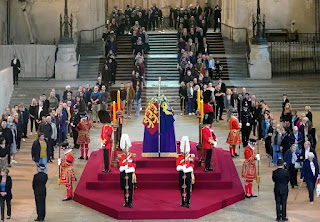Last Saturday marked the first anniversary of Queen Elizabeth II's death and after seeing all the tributes, photos and videos on social media, I'm reflecting on the mourning period and the day England and the world said goodbye to the longest reigning monarch.
As I watched the Lying-In-State and funeral, I was curious about who the people standing guard and marching in the processions are and what their actual jobs are, so I did some research and here I am sharing what I found.
The Organiser
Queen Elizabeth II's funeral was organised by Edward Fitzalan-Howard, the 18th Duke of Norfolk. As the highest ranking Duke in the country, he holds the title of Earl Marshall and his role involves overseeing major ceremonial occasion,such as the Platinum Jubilee, Queen's funeral and the King's coronation.
Lying In State
Three ceremonial units kept vigil around the Queen's coffin as she was lying in state in Westminster Hall.
The Gentleman of Arms, the most senior of the sovereign's guards, stood closest to the coffin. They were bodyguards to the queen at many ceremonial events. They attend the sovereign at State arrivals of foreign Heads of state, the Garter service at Windsor, the State Opening of Parliament, and the garden parties, where their task is to form the lanes the Royal Family walks though.
The Royal Company of Archers are the sovereigns official guards in Scotland. They perform duties at State and ceremonial occasions as requested by the King when he is there and the Royal Company's most regular duty is to attend the annual garden party at the Palace of Holyroodhouse. When not serving as bodyguards, the Royal Company of Archers is an archery club, the purpose for which it was originally formed.
The Yeomen of the Guard members could be seen standing at the outer corners of the catafalque at the lying in state. They take part in many royal occasions including the annual Royal Maundy Service, the State Opening of Parliament and all investiture ceremonies and garden parties at Buckingham Palace.
Funeral Procession
The Royal Family, the military and many people who worked for the Queen marched in the funeral procession to Westminster Abbey and then to Windsor.
Eight members of the Queen's Company, 1st Battalion Grenadier Guards formed the Bearer Party, carrying the 250-317kg lead-lined coffin from Westminster Hall onto the gun carriage, down the long aisle of Westminster Abbey for the funeral service,and back out at the end. When the procession reached Wellington Arch, they put the coffin into the hearse and then carried it into St George's Chapel in Windsor for the Committal service. The Pallbearers were lead by two officers, one walking ahead of them and another walking behind and giving instructions. The Grenadier Guards is the most senior, infantry regiment of the British Army. They are one of seven regiments of the Household Division and they can be seen guarding Buckingham Palace, St James's Palace and the Tower of London. Aside from ceremonial duties, they specialize in light role infantry operations, defending the crown and country against any threats and deploy anywhere in the world with short notice. Some of the pallbearers had flown back from Iraq for the funeral. They and Other Grenadier Guards marched alongside the gun carriage.
Photo: NY Breaking
142 Royal Navy Sailors wearing blue and white uniforms pulled the gun carriage through the streets of London. They were at the front and back. The Royal Navy are committed to maritime security operations around the world and protect maritime trade from pirates, terrorists and traffickers.
The Royal Company of Archers, Yeomen of the Guard and Gentlemen of Arms who stood guard at the Queen's Lying in State marched on both sides of the Gun Carriage,
Mounted Metropolitan Police lead the entire porcession, ahead of the Royal Canadian Mounted Police, Bands of the Rifles and Brigade of Gurkhas The Mounted police duties include traffic and crowd control, riot control, patrols and ceremonial protocol duties The Band of the Rifles serves the sole rifle regiment, It is the most senior of three bands of the regiment but the only one that is part of the regular army. The musicians are members of the Royal Corps of Army Music. The Brigade of Gurkhas is the collective name given to all units in the British Army that are composed of Nepalese Ghurka soldiers.
Photo: BloodHorse
Also marching towards the front of the procession were Representative detachments of Commonwealth forces including the Royal Australian Air Force Reserve, Royal Australian Army Nursing Corps, Royal Australian Army Ordnance Corps, Royal Australian Infantry Corps, Royal Australian Engineers, Royal Regiment of Australian Artillery and The Royal Australian Navy. These representatives are in the army and serve and protect their own countries.
Photo: 9News
Representatives of Civilian Services marched behind the gun carriage. 88 people representing ten different services including Police, Fire, Merchant Navy and St John Ambulance took part. The Band of The Royal Marines and more Mounted Metropolitan Police were at the rear.
Photo: iNews
Photo: NBC News
It was a grand, emotional and fitting farewell to the much-loved monarch, Queen Elizabeth II, who will always be remembered.








Comments
Post a Comment